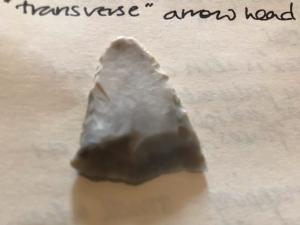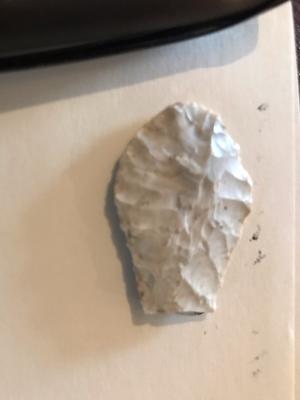30 March, British Summer Time, a select gathering in a pub in Reeth, sleety snow blowing around the doorway.
We had come together to touch, hear, and think about lithics - worked and used stone objects derived in the main from flint and chert, under the knowledgeable and passionate guidance of Ric Carter, SWAAG trustee and Heather, a fellow SWAAG member.
Following a description of the characteristics of flint and chert (hard siliceous stones which can be quickly split into conchoidal pieces and shaped to form sharp edges) Ric and Heather passed round some of their collection of scrapers, saws, arrowheads, small sharp barbs, and lumps of partially worked and unworked stone. Mesolithic and Neolithic ancestors used the worked pieces for hunting, butchery, and other tasks, including trepanning. Their tools for doing this were hard stones and antler tips. In the Neolithic flint knapping became specialist work. Despite metal becoming available to produce artefacts, chert and flint continued to be worked. Looking at a barbed flint arrowhead, dated as Bronze Age, we considered the pride and artistic endeavour which would have been part of this activity. We also discovered that flint has a distinctive smell when split, that Mesolithic artefacts have more patina than Neolithic ones, and that the term “weapons grade chert” was coined by Tim Laurie.
Chert is found locally near Reeth whereas flint is often found at distance from the place of its geological formation. These hard stones were highly valued, and nodules would be worked (knapped) till they were too small for it to be possible to continue doing so. In some cases, the core of a stone could be “rejuvenated” by reshaping to make the last of it more workable.
We were reminded by Les Knight that finds of worked and unworked flint, in areas where flint is not part of the local geology, may not necessarily be because of importation by humans. Glaciation is likely to account for nodules of flint found in boulder clay in areas remote from the place in which they were formed, thus spreading the availability of a good material for tool and weapon making. Les also showed us a piece of worked stone (possibly volcanic) from the Lake District.
But the best was saved for last! We all handled a crude chopping flint, comfortable to hold, which Ric and his Dad found (some time ago) down south in their garden. Having sought expert opinion on the age of this find they were informed that it was 300,000 years old! So, what is in your garden?
S. I. |



